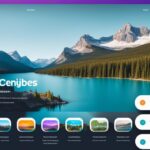Table of Contents
Microinteractions design has revolutionized the world of interactive design, enriching user engagement and enhancing digital experiences. These small yet impactful animations and responses have become indispensable elements in creating a seamless user experience. From delighting users to providing system feedback, microinteractions play a vital role in capturing and retaining users’ attention.
In the realm of interactive design, microinteractions have the power to captivate users and foster a deeper connection with the interface. They are essential for improving user engagement and creating delightful digital experiences. By employing microinteractions, designers have the ability to elevate their designs, making them more interactive, dynamic, and visually appealing. These interactions have the potential to transform mundane tasks into enjoyable journeys.
Microinteractions are integral to interactive design, as they provide real-time feedback, communicate system status, guide user behavior, and establish an emotional connection with users. These interactions can be implemented in various ways, such as button animations, hover effects, loading screens, and playful surprises. Each microinteraction serves a unique purpose in enhancing user engagement and optimizing digital experiences.
As the demand for seamless user experiences continues to grow, designers must recognize the power of microinteractions. By incorporating these design elements, they can create interactive interfaces that not only engage users but also leave a lasting impression. Through thoughtful microinteractions design, the possibilities for enhancing user interaction and creating captivating digital experiences are limitless.
Delightful Microinteractions for Enhanced User Experience
When it comes to designing interactive experiences, incorporating delightful microinteractions can make a world of difference. These small yet impactful animations and responses add a personal touch and create a sense of joy for users, ultimately enhancing their overall experience. By integrating delightful microinteractions, designers can instantly capture the user’s interest and make a positive first impression.
One example of a delightful microinteraction is the use of jumping emojis for Facebook likes. Instead of a simple static icon, the emojis come to life with a playful bounce, adding an element of surprise and delight for users. This small animation not only draws attention to the interaction but also creates a memorable moment that users can engage with and enjoy.
Another application of delightful microinteractions is in the onboarding experience. Instead of a mundane introductory screen, designers can incorporate engaging animations that guide users through the onboarding process. These animations not only make the experience more visually appealing but also provide a clear and intuitive way for users to familiarize themselves with the interface.
By leveraging delightful microinteractions, designers can create a wow factor that leaves a lasting impression on users. These small design elements not only enhance user engagement but also contribute to a more positive onboarding experience. Whether it’s a whimsical animation or an unexpected surprise, delightful microinteractions have the power to captivate users and elevate the overall user experience.
| Moment of Delight | Description |
|---|---|
| Jumping Emojis | Facebook likes with emojis that bounce for added excitement and engagement. |
| Engaging Onboarding | Incorporating animations and interactive elements for a more captivating onboarding experience. |
| Whimsical Animations | Playful animations that surprise and delight users, creating a memorable experience. |
| Unexpected Surprises | Incorporating hidden surprises and Easter eggs that bring joy and delight to users. |
Attention-Grabbing Microinteractions for User Engagement
Microinteractions play a crucial role in capturing and maintaining the user’s attention without causing distractions. By incorporating subtle button animations, hover effects, and dynamic carousels, designers can guide users through the interface and keep them engaged throughout their digital journey.
Button animations are an effective way to draw attention to specific actions or features. By adding subtle motion to buttons, such as a gentle bounce or a smooth transition, users are enticed to interact and explore further. These animations create a sense of responsiveness, making users feel more connected to the interface.
Hover effects are another attention-grabbing microinteraction technique. When users hover their cursor over interactive elements, such as buttons or links, designers can implement visual cues to provide feedback and encourage interaction. This can be achieved through color changes, underline effects, or even subtle animations that highlight the interactive nature of the element.
Incorporating dynamic carousels is another way to capture attention and encourage engagement. Carousels allow designers to showcase multiple pieces of content or features within a confined space, creating an intriguing visual experience. By incorporating smooth transitions and interactive navigation, users are encouraged to explore different parts of the interface, increasing their overall engagement.
“Subtle button animations, hover effects, and dynamic carousels are effective ways to guide users and keep them engaged.”
Examples of Attention-Grabbing Microinteractions
To further illustrate the impact of attention-grabbing microinteractions, let’s take a look at some real-world examples:
- Facebook’s “Like” Button Animation: When users interact with the “Like” button on Facebook, the iconic thumbs-up icon comes to life with a bouncing animation, capturing the user’s attention and reinforcing their action.
- Netflix’s Hover Effects: When hovering over movie thumbnails on Netflix, users are presented with additional information and a trailer preview, enticing them to click and explore the content further.
- Amazon’s Dynamic Carousels: On the Amazon homepage, dynamic carousels display personalized product recommendations, showcasing different products and encouraging users to discover new items of interest.
These examples highlight how attention-grabbing microinteractions can elevate user engagement and make digital experiences more interactive and enjoyable.
| Microinteraction Technique | Key Features |
|---|---|
| Button Animations | – Subtle motion – Responsive feedback – Increased interactivity |
| Hover Effects | – Visual cues – Interactive feedback – Encourages exploration |
| Dynamic Carousels | – Showcase multiple content – Smooth transitions – Encourage discovery |
By implementing attention-grabbing microinteractions, designers can create engaging interfaces that capture and hold the user’s attention, ultimately enhancing the overall user experience.
Feedback and Responsiveness through Microinteractions
Microinteractions play a critical role in providing users with timely feedback and enhancing responsiveness in interactive design. These small animations and responses keep users informed about the system’s response to their actions, improving usability and reducing uncertainty. Whether it’s validating form inputs or indicating progress, microinteractions offer immediate feedback that reassures users and enhances their perception of control.
Form Validation:
One of the key ways microinteractions contribute to feedback and responsiveness is through form validation. By providing real-time validation, such as displaying error messages when incorrect data is entered, microinteractions guide users to correct their mistakes instantly. This ensures a smoother user experience as users can promptly rectify errors without having to submit the form and wait for a response. Form validation microinteractions not only help users avoid frustration but also increase input accuracy.
Progress Indicators:
Progress indicators are another example of microinteractions that deliver feedback and improve responsiveness. These subtle animations or status updates inform users about the progress of their actions, whether it’s file uploads, form submissions, or page loading. By providing visual cues, such as progress bars or percentage indicators, microinteractions eliminate uncertainty and keep users engaged during waiting periods. Progress indicators demonstrate that the system is actively processing their request, reducing perceived wait time and minimizing user frustration.
“Microinteractions offer immediate feedback and enhance the user experience by reducing uncertainty and increasing the user’s perception of control.”
By incorporating feedback microinteractions, designers create a seamless and intuitive user experience. These microinteractions empower users by keeping them informed and engaged, ultimately enhancing the overall satisfaction and usability of the design.
Example: Feedback Microinteractions in Action
Let’s take a look at an example that showcases the effectiveness of feedback microinteractions. Imagine a registration form where users input their personal details. As users type, microinteractions immediately validate each field and provide appropriate feedback. If the user enters an invalid email address, a microinteraction could display an error message next to the email input field, ensuring users can quickly identify and correct the error without submitting the form and starting over.
| Feedback Microinteractions | Benefits |
|---|---|
| Real-time validation | Users can instantly address errors and input accurate data. |
| Visual cues | Progress indicators assure users that their actions are being processed. |
| Enhanced user perception | Users feel more in control and confident in their interactions with the system. |
Creating an Emotional Connection with Microinteractions
Microinteractions have the power to evoke emotions and establish a strong connection between the user and the interface. By incorporating playful animations and unexpected surprises, designers can create a positive emotional response, leaving users with a memorable and enjoyable experience.
Playful animations add an element of delight, injecting a sense of fun and playfulness into the user’s interactions. They bring the interface to life and create an engaging and dynamic experience. Whether it’s a subtle bounce, a satisfying transition, or an entertaining interaction, these playful animations evoke a sense of joy and create a lasting impression.
Unexpected surprises, on the other hand, captivate users by introducing elements of surprise and delight. These surprises can take the form of hidden easter eggs, unexpected animations triggered by specific actions, or personalized interactions tailored to the user’s preferences. By adding these unexpected surprises, designers create moments of delight, reinforcing the emotional connection between the user and the interface.
Incorporating microinteractions that create an emotional connection is crucial for designers to establish a strong bond with users. By evoking positive emotions through playful animations and surprises, designers can create a user experience that is not only functional but also emotionally engaging and memorable.
Case Study: Snapchat’s Playful Snap Streaks
Snapchat’s snap streaks feature is a prime example of how playful animations can create an emotional connection with users. Snap streaks represent consecutive days of sending snaps to friends, and they are symbolized by a fire emoji. As the streak progresses, the fire emoji becomes more animated and vibrant, capturing the user’s attention and excitement.
Key Takeaways
- Playful animations and unexpected surprises evoke positive emotions and create a lasting emotional connection with users.
- Playful animations add an element of delight, injecting fun and playfulness into the user experience.
- Unexpected surprises captivate users by introducing moments of surprise and delight.
- Designers can use microinteractions to create an emotional bond with users, enhancing the overall user experience.
Communicating System Status through Microinteractions
In the realm of interactive design, microinteractions serve as powerful tools for effectively communicating the status of ongoing processes and system changes. These subtle yet impactful animations, such as loading animations, progress indicators, and skeleton screens, play a vital role in reassuring users that the system is actively working in the background. By employing these microinteractions, designers can prevent frustration, confusion, and disengagement during waiting periods.
When users encounter a loading animation, they understand that the system is processing their requested action. This visual cue not only keeps them informed but also helps manage their expectations. It creates a sense of progress, reassuring them that their request has been acknowledged and is being executed. This prevents users from feeling left in the dark and cultivates trust in the system.
Similarly, progress indicators convey the completion status of longer processes or multiphase tasks. By presenting a visual representation of the progress, users can estimate the time required to accomplish their objective. Progress indicators lend transparency to complex operations, mitigating restlessness and enhancing user experience through clear communication.
Elevating the Waiting Experience with Skeleton Screens
An innovative microinteraction technique, skeleton screens give users a sneak peek of the content yet to load. Instead of presenting a blank space or a stagnant loading animation, designers can offer users a partial view of the interface by displaying an outline or structure. This creates the illusion that the system is loading quickly, reducing the perception of waiting time and providing a more engaging waiting experience. Skeleton screens keep users visually engaged, guiding their attention to the main content while the rest of the interface loads in the background.
Microinteractions play a crucial role in ensuring that users feel connected to the system, even during moments of waiting. By implementing loading animations, progress indicators, and skeleton screens, designers can maintain user engagement and prevent frustration, while effectively communicating the ongoing system status.
Example: Skeleton Screens in Action
Let’s take a look at an example of how skeleton screens can be integrated into an interface:
| Without Skeleton Screens | With Skeleton Screens |
|---|---|
In the image on the left, users are presented with a blank space while the content loads. This can result in a disengaging waiting experience, leading to user frustration or abandonment. On the other hand, the image on the right showcases a skeleton screen. Users can see the overall structure and anticipate the content that will appear, creating a more engaging waiting experience. Skeleton screens maintain user interest and minimize the sensation of waiting, enhancing the overall usability of the interface.
Guiding User Behavior with Microinteractions
When it comes to interactive design, microinteractions can serve as powerful tools for guiding user behavior within an interface. By strategically implementing microinteractions, designers can influence users and encourage desired actions. Whether it’s a pulsating call-to-action button or a subtle animation, these interactive elements can prompt users to take specific actions, resulting in a more engaging and seamless user experience.
One effective way to guide user behavior is through the use of pulsating call-to-action buttons. By making the button appear dynamic and interactive, users are more likely to be drawn to it and take action. The pulsation effect can create a sense of urgency and highlight the importance of the call-to-action, increasing the chances of user engagement.
Furthermore, microinteractions can be used to guide users through completing forms or exploring additional features. By incorporating interactive elements into the interface, such as tooltips or contextual cues, users are provided with clear directions and prompts. These interactive elements not only enhance the user’s understanding but also make the process more intuitive and enjoyable.
“Microinteractions can effectively guide users and encourage them to explore and interact more actively with the interface.”
Additionally, interactive elements can be used to influence user behavior by providing feedback or rewards. For example, a progress bar that updates as users complete certain tasks can encourage them to continue and complete the entire process. Similarly, gamification elements, such as badges or achievements, can motivate users to explore different features and take desired actions.
The use of interactive microinteractions is crucial in guiding user behavior and optimizing the overall user experience. By incorporating pulsating call-to-action buttons, interactive elements for form completion, and feedback mechanisms, designers can ensure that users navigate the interface effortlessly and are guided towards their intended goals.
Summary:
- Microinteractions can guide user behavior within an interface.
- Pulsating call-to-action buttons prompt users to take action.
- Interactive elements assist users in completing forms and exploring features.
- Feedback mechanisms and rewards can influence user behavior.
Conclusion
In conclusion, microinteractions play a significant role in enhancing user experience and creating a sense of delight in interactive design. These small animations and responses have the power to engage users and elevate digital experiences. Whether it’s through capturing attention, providing feedback, communicating system status, or guiding user behavior, microinteractions are essential elements that contribute to a memorable and exceptional user experience.
By implementing thoughtfully designed microinteractions, designers can create user interfaces that not only fulfill functional requirements but also evoke positive emotions and establish a strong connection with users. Delightful microinteractions add a personal touch and create a sense of joy, while attention-grabbing microinteractions capture the user’s interest and keep them engaged. Feedback and responsiveness through microinteractions provide reassurance and improve the user’s perception of control.
Microinteractions are versatile tools that can be used in various contexts to enhance user engagement and create an enhanced user experience. Whether it’s a loading animation, a button animation, or a playful animation that surprises and delights, microinteractions have the power to make a lasting impression. By incorporating these design elements, designers can create digital experiences that leave a positive impact on users and keep them coming back for more.
FAQ
What are microinteractions?
Microinteractions are small animations and responses in interactive design that enhance user engagement and elevate digital experiences. They are used for purposes like delight, user engagement, system status, and minimalization.
How do delightful microinteractions enhance user experience?
Delightful microinteractions add a personal touch and create a sense of joy for users. They instantly capture the user’s interest and make a positive first impression. Examples include Facebook likes with jumping emojis and onboarding screens with engaging animations.
How can microinteractions grab the user’s attention?
Microinteractions can capture the user’s attention without distracting them from the task at hand. Subtle button animations, hover effects, and dynamic carousels are effective ways to guide users and keep them engaged. These microinteractions provide visual cues that direct users through the interface and encourage interaction.
What role do microinteractions play in providing feedback to users?
Microinteractions offer immediate feedback to users, keeping them informed about the system’s response to their actions. They enhance usability and reduce uncertainty by highlighting errors in form validation or displaying progress indicators. Microinteractions provide reassurance and improve the user’s perception of control.
How do microinteractions create an emotional connection with users?
Microinteractions have the power to evoke emotions and establish a connection between the user and the interface. Playful animations and unexpected surprises create a positive emotional response and leave users with a memorable and enjoyable experience. By incorporating these microinteractions, designers can create a strong emotional bond with users.
How do microinteractions communicate system status?
Microinteractions effectively communicate the status of ongoing processes or system changes. Loading animations, progress indicators, and skeleton screens reassure users that the system is working and prevent frustration or confusion. These microinteractions provide visual cues that keep users informed and engaged during waiting periods.
How can microinteractions guide user behavior within an interface?
Microinteractions can be used to guide users and influence their behavior within an interface. A pulsating call-to-action button or a subtle animation can prompt users to take action. Interactive elements can guide users through completing forms or exploring additional features. These microinteractions provide a seamless user experience and encourage desired actions.







